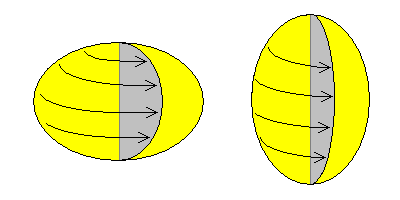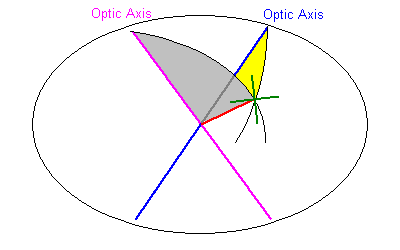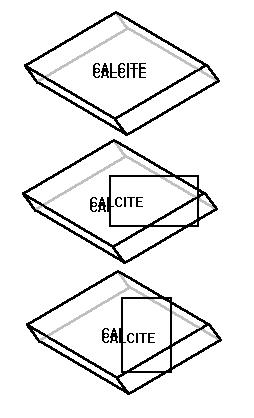The Uniaxial Indicatrix
Steven Dutch, Professor Emeritus, Natural and Applied Sciences, Universityof Wisconsin - Green Bay
 | If we rotate an ellipse around its major or minor axis, we sweep out an ellipse with a circular cross section. Such an ellipsoid is called an ellipsoid of revolution. If we rotate around the minor axis we get a shape that is flattened along the rotation axis (left); if we rotate around the major axis the ellipsoid is elongated along the rotation axis. |
A material with an indicatrix of this shape is called uniaxial. There is only one optic axis: down the axis of revolution. Uniaxial materials obviously must have one principal symmetry axis and be tetragonal, hexagonal, or trigonal. Quartz, calcite, corundum, beryl, rutile, tourmaline and nepheline are important uniaxial minerals.
It's useful to know not just whether a mineral is uniaxial, but which of the two types of indicatrix it has. If the refractive index along the symmetry axis is smaller, the mineral has the indicatrix at left and is said to be optically negative. If the refractive index along the symmetry axis is greaterer, the mineral has the indicatrix at right and is said to be optically positive.
There's an easy memory trick to keep the two straight. The negative indicatrix is flat like a minus sign. The positive indicatrix is tall like the upright stroke in a plus sign.
The refractive index in the optic axis direction is usually symbolized by the Greek letter epsilon (ε) and the refractive index in the circular section is usually symbolized by the Greek letter omega (ω). The sign of (ε - ω) is the optic sign.
Vibration directions in Uniaxial Crystals
When light enters any birefringent crystal, it splits into two beams polarized at right angles to each other. These beams vibrate perpendicular to the ray path. The plane of the vibration directions cuts the indicatrix in an elliptical cross section, and the vibration directions correspond to the major and minor axes of the ellipse. In other words, the light beams find the fastest and slowest vibration directions.
But how does it know? Well, it doesn't. Like any vector, we can resolve the electric field into components. In some cases our choice of axes is arbitrary. For example, if I want to describe the flight of a plane, I might break its velocity down into a north-south and an east-west component. I could just as easily have picked components oriented NW-SE and NE-SW. The wings and fuselage of the plane won't travel at different speeds if I choose one set of axes over the other. But in a crystal, it does make a difference, because the vector components will result in light moving at different speeds. The component of the electric field vector oriented in the direction of lowest refractive index will result in light with the highest possible speed, and the component oriented in the direction of highest refractive index will result in light with the lowest possible speed.
So we can see that we must get light moving at the fastest and slowest possible speeds for the given material, but why only those speeds? Why not a continuous spread of velocity? Because for any light entering the crystal, the component of the electric field in the fast vibration direction will produce light moving at the fastest possible speed. That light is off to the races and gone, and the only part of the original electric field that's left is the component at right angles to the fast direction, which produces light with the slowest possible speed.
If the ray travels down the optic axis, the cross section perpendicular to the ray is a circle, and the crystal appears isotropic. The further the ray path is from the optic axis, the more elliptical the cross section.
The uniaxial indicatrix is an ellipsoid of revolution, the shape obtained when an ellipse is revolved around its major or minor axis. If the ellipse revolves around its major axis, the ellipsoid will be elongated along the rotation axis and the equatorial radius of the ellipsoid equals the minor axis of the ellipse. If the ellipse revolves around its minor axis, the ellipsoid will be flattened along the rotation axis and the equatorial radius of the ellipsoid equals the major axis of the ellipse. In the first case the equatorial radius of the ellipsoid is the smallest radius of the ellipsoid, in the second case it is the longest. In either case, a cross section through the ellipsoid always has either its major or minor axis in the equatorial plane.
Therefore, when light enters a uniaxial crystal, one of its vibration directions always is in the equatorial plane of the indicatrix. This light, which is vibrating in the circular section of the indicatrix, behaves as if the crystal is isotropic. This ray is called the ordinary ray (or o-ray for short).
The other vibration direction is at right angles. It lies in the plane containing the optic axis and the ray path. This light doesn’t behave as if the crystal is isotropic, and this ray is called the extraordinary ray or e-ray.
Now we can see the reason for the symbols used for the refractive indices. The Greek letter epsilon (ε = e) stands for extraordinary and the Greek letter omega (ω = o) stands for ordinary.
What’s the difference? Consider a piece of glass or halite sitting on a piece of paper. According to Snell’s Law, light striking the surface of the material at right angles should go straight through without deviating (sin i = 0= sin r). Now consider a calcite cleavage rhomb sitting on that piece of paper. Everything on the paper appears double. Obviously some of the light is not passing straight through and is not obeying Snell’s Law. The ordinary ray obeys Snell’s Law, which is why it’s ordinary. The other one doesn’t, and that’s why it’s extraordinary. Calcite is one of the few materials where the difference is big enough to see with the unaided eye. (So what law does the extraordinary ray follow?)
 | Another way to picture the vibration directions is the Biot-Fresnel Rule. For a biaxial crystal, given a random ray direction (red):
|
 | If we move the optic axes together, the indicatrix becomes more and more similar to a uniaxial indicatrix. When the axes coincide, one vibration direction will be in the plane containing the ray path and the optic axis, and the other will be at right angles. |
Understanding Calcite
 | When we examine the double refraction of calcite through polarizing filters, we find several interesting things:
|
 | It's easy to tell which ray is which. Draw a long line and place the calcite rhomb over it. One image of the line will appear to pass straight through the crystal. That's the ordinary ray; it's behaving like Snell's Law says it should. If you're looking perpendicular to the rhomb face, the line should pass right through without bending. The other image of the line is offset toward the corner where the obtuse angles of three faces meet. That's obviously the extraordinary ray, which is not behaving like Snell's Law predicts. The two vertices where three obtuse angles meet mark the three-fold symmetry axis of the calcite. This is also the optic axis. The ordinary ray is polarized in a plane perpendicular to the three-fold (optic) axis, and the extraordinary ray is polarized in the plane parallel to the three-fold (optic) axis. |
So What Law Does the Extraordinary Ray Follow?
 | It's a fundamental principle in science that everything follows laws. So if the extraordinary ray doesn't follow Snell's Law, it must follow a more complex law. For light in space, air, water, or glass, the light waves move perpendicular to the wave fronts, and the ray path is perpendicular to the light waves. Not in birefringent materials. Here we have to distinguish between the line perpendicular to the light waves, the wave normal, and the ray path, the actual direction the waves travel. The wave normal, obeys Snell’s Law, but the actual direction the waves travel (the ray path) doesn’t. The waves sidestep as they advance. The difference is small even for the most birefringent materials, and in the diagram at left the difference is greatly exaggerated. |
 | The rule is actually pretty simple. This time we need to look at a cross section of the indicatrix in the plane containing the ray path and the optic axis. Draw a line parallel to the ray path (red) and just touching (tangent to) the ellipse. From the point of contact, draw a diameter of the ellipse (blue). These two directions are called conjugate radii. Where one radius intersects the ellipse, the tangent at that point is parallel to the other radius. The extraordinary ray and the wave fronts are conjugate radii. |
 | At left is an accurate drawing of the situation with calcite. The maximum divergence of the wave normal from the ray path is a bit over 3 degrees. The maximum and minimum refractive indices of calcite differ by about 11%, one of the largest variations among minerals. |
Return to Mineralogy-Petrology Index
Return to Thin-Section Index
Return to Crystals and Light Index
Return to Crystal Structures Index
Return to Mineral Identification Tables
Return to Professor Dutch's Home Page